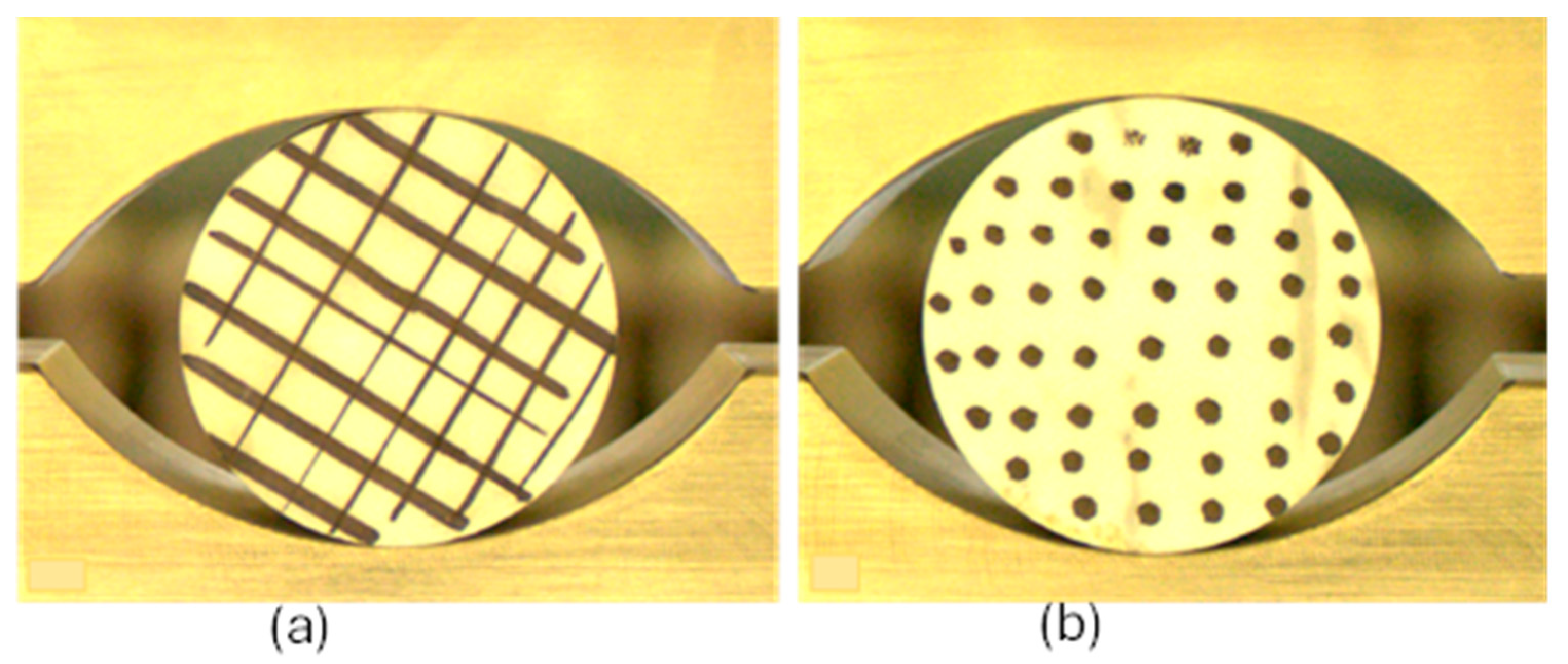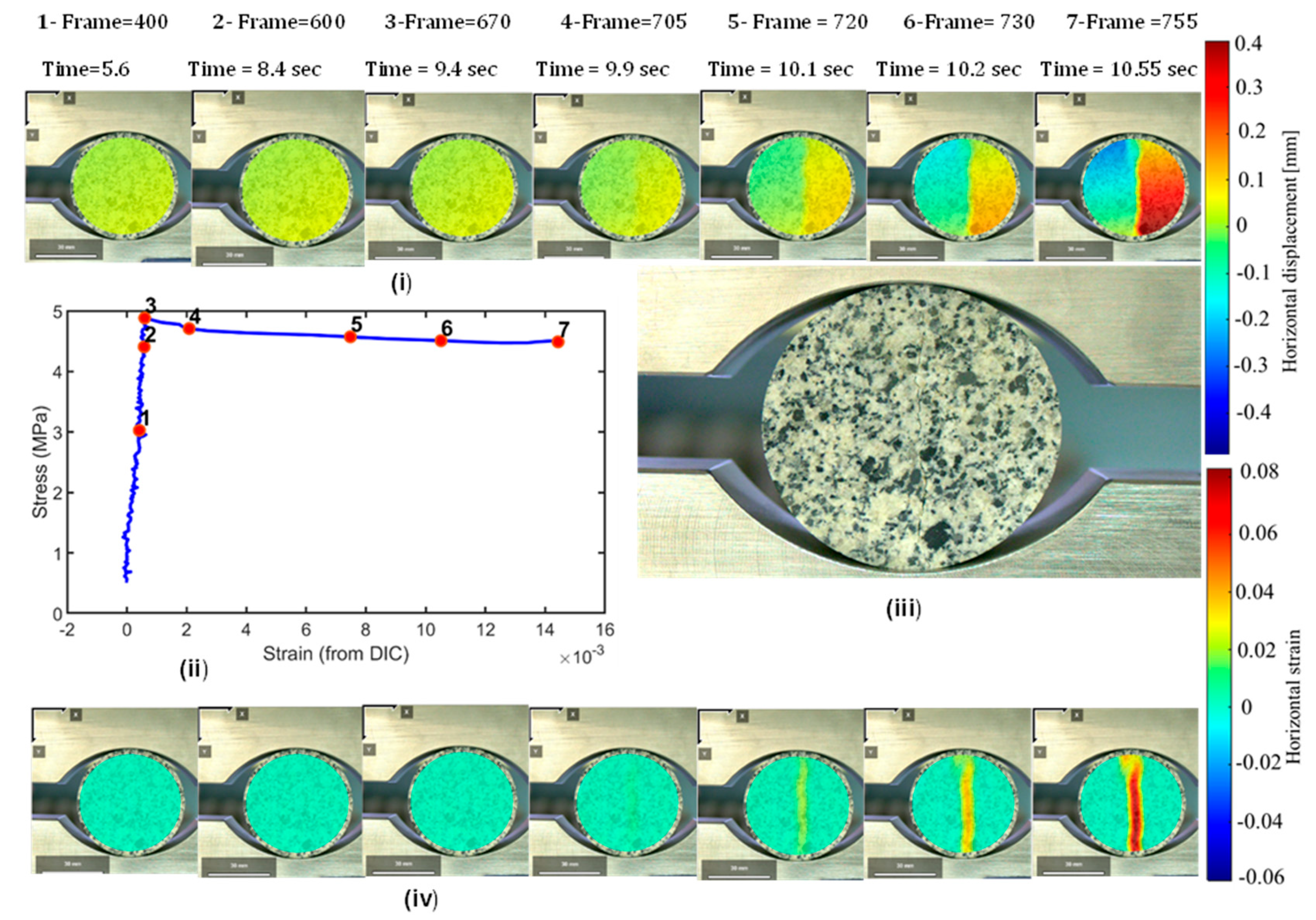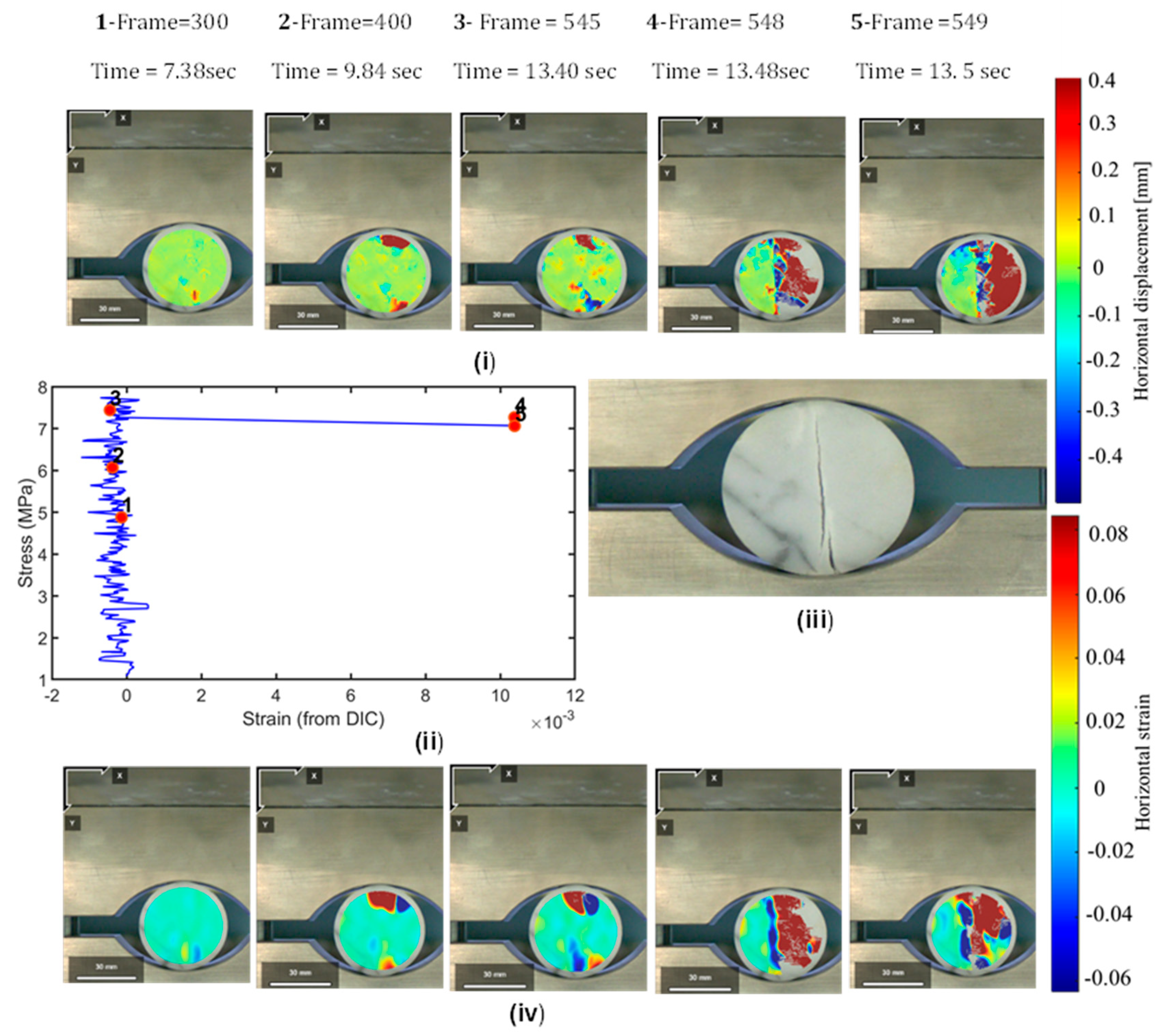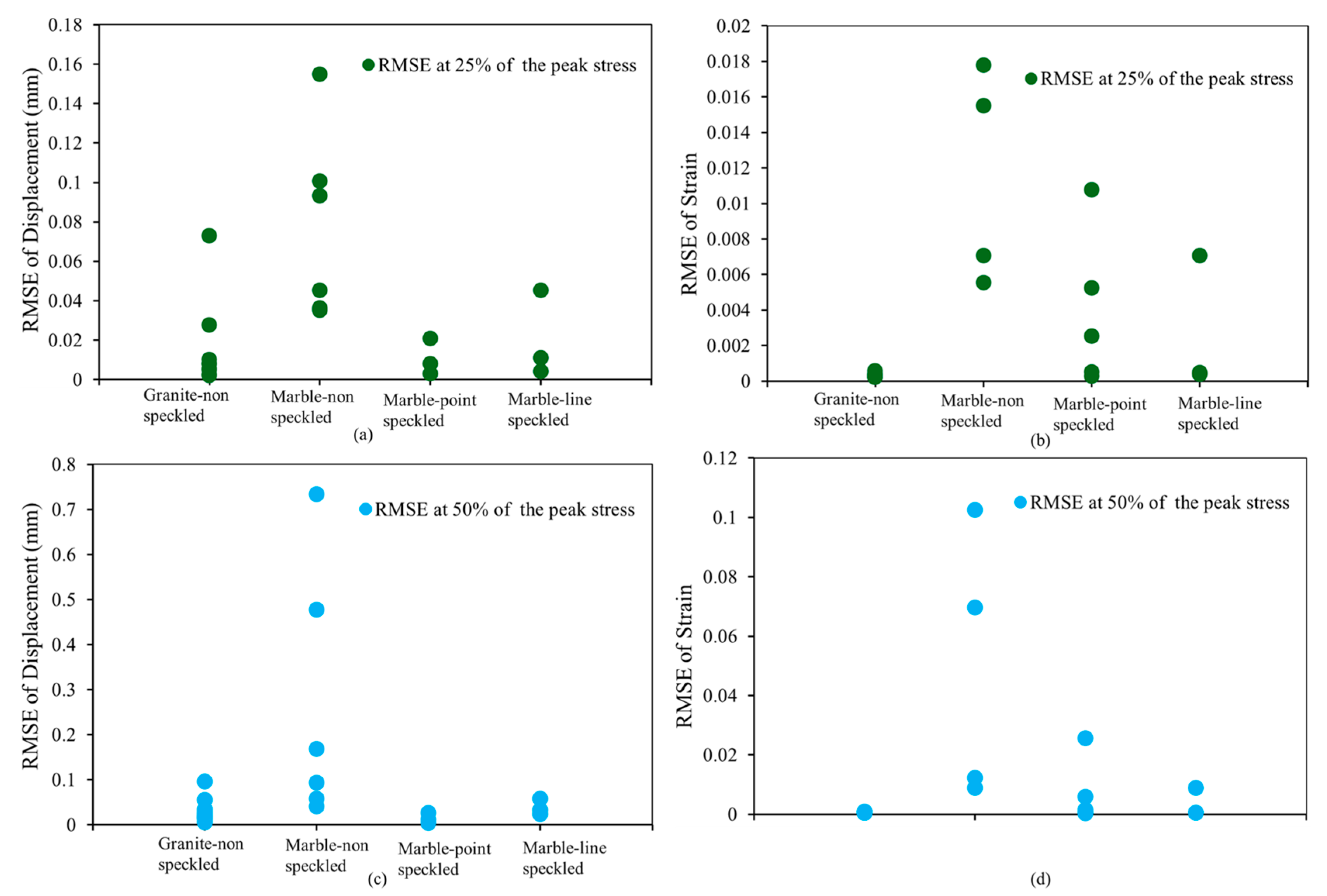Effects of Rock Texture on Digital Image Correlation
Abstract
1. Introduction
2. Materials and Methods
2.1. Sample Preparation
2.2. Experimental Procedure
2.3. Digital Image Correlation
3. Results
3.1. Physical and Mechanical Tests
3.2. DIC Analysis
3.2.1. Tonalite Without Speckles
3.2.2. Marble with Line Speckles
3.2.3. Marble with Point Speckles
3.2.4. Marble Without Speckles
4. Discussion
4.1. DIC Results in the Absence of Artificial Speckles
4.2. DIC Results in the Presence of Artificial Speckles
5. Conclusions
- The natural textural and mineral contrast of the tonalite samples provides sufficient surface texture for DIC analysis without artificial speckle patterns, achieving a 100% success rate across tested samples.
- Homogeneous marble without speckle patterns is challenging, and results may not be obtained due to a lack of adequate surface contrast. Nevertheless, the presented results highlight the capability of DIC to identify relevant features of strain distribution even in the absence of speckles. In this study, only 31.6% of non-speckled marble samples were successful in DIC analysis.
- Marble samples with speckle patterns resulted in good deformation evolution, except for some distortion and directional bias. Line-speckled samples achieved a 100% success rate, while point-speckled samples succeeded in 75% of cases.
- The overall DIC success rate across all samples was 61.1%, highlighting the importance of appropriate surface preparation for reliable results.
Author Contributions
Funding
Data Availability Statement
Conflicts of Interest
References
- Yan, X.; Liu, Y.; Yang, S.; Jin, Y.; Chen, M. Experimental Investigation on Failure Characteristics of Pre-Holed Jointed Rock Mass Assisted with AE and DIC. Appl. Sci. 2024, 14, 7655. [Google Scholar] [CrossRef]
- Chen, F.; Wang, E.; Zhang, B.; Zhang, L.; Meng, F. Prediction of Fracture Damage of Sandstone Using Digital Image Correlation. Appl. Sci. 2020, 10, 1280. [Google Scholar] [CrossRef]
- Caselle, C.; Umili, G.; Bonetto, S.; Ferrero, A.M. Application of DIC Analysis Method to the Study of Failure Initiation in Gypsum Rocks. Geotech. Lett. 2019, 9, 35–45. [Google Scholar] [CrossRef]
- Chai, J.; Liu, Y.; Ouyang, Y.B.; Zhang, D.; Du, W. Application of Digital Image Correlation Technique for the Damage Characteristic of Rock-like Specimens under Uniaxial Compression. Adv. Civ. Eng. 2020, 2020, 8857495. [Google Scholar] [CrossRef]
- Li, D.; Li, B.; Han, Z.; Zhu, Q. Evaluation on Rock Tensile Failure of the Brazilian Discs under Different Loading Configurations by Digital Image Correlation. Appl. Sci. 2020, 10, 5513. [Google Scholar] [CrossRef]
- Tudisco, E.; Etxegarai, M.; Hall, S.A.; Charalampidou, E.M.; Couples, G.D.; Lewis, H.; Tengattini, A.; Kardjilov, N. Fast 4-D Imaging of Fluid Flow in Rock by High-Speed Neutron Tomography. J. Geophys. Res. Solid Earth 2019, 124, 3557–3569. [Google Scholar] [CrossRef]
- Yang, Z.; Wu, J.; Cui, Z.; Qiu, Y.; Song, G.; Ma, Y.; Feng, Z.; Du, M.; Geng, S.; Chen, S. Digital Image Correlation Analysis of Crack Initiation and Failure in Heat-Treated Granite during the Brazilian Test. Geothermics 2024, 121, 103042. [Google Scholar] [CrossRef]
- Yue, Z.; Song, Y.; Li, P.; Tian, S.; Ming, X.; Chen, Z. Applications of Digital Image Correlation (DIC) and the Strain Gage Method for Measuring Dynamic Mode I Fracture Parameters of the White Marble Specimen. Rock Mech. Rock Eng. 2019, 52, 4203–4216. [Google Scholar] [CrossRef]
- Zambrano, M.; Hameed, F.; Anders, K.; Mancini, L.; Tondi, E. Implementation of Dynamic Neutron Radiography and Integrated X-Ray and Neutron Tomography in Porous Carbonate Reservoir Rocks. Front. Earth Sci. 2019, 7, 329. [Google Scholar] [CrossRef]
- Reu, P.L.; Blaysat, B.; Andó, E.; Bhattacharya, K.; Couture, C.; Couty, V.; Deb, D.; Fayad, S.S.; Iadicola, M.A.; Jaminion, S.; et al. DIC Challenge 2.0: Developing Images and Guidelines for Evaluating Accuracy and Resolution of 2D Analyses: Focus on the Metrological Efficiency Indicator. Exp. Mech. 2022, 62, 639–654. [Google Scholar] [CrossRef]
- Chu, T.C.; Ranson, W.F.; Sutton, M.A. Applications of Digital-Image-Correlation Techniques to Experimental Mechanics. Exp. Mech. 1985, 25, 232–244. [Google Scholar] [CrossRef]
- Bay, B.K.; Smith, T.S.; Fyhrie, D.P.; Saad, M. Digital Volume Correlation: Three-Dimensional Strain Mapping Using X-Ray Tomography. Exp. Mech. 1999, 39, 217–226. [Google Scholar] [CrossRef]
- Caselle, C.; Bonetto, S.; Costanzo, D. Crack Coalescence and Strain Accommodation in Gypsum Rock. Frat. Ed Integrita Strutt. 2020, 14, 247–255. [Google Scholar] [CrossRef]
- Wong, L.N.Y.; Zou, C.; Cheng, Y. Fracturing and Failure Behavior of Carrara Marble in Quasistatic and Dynamic Brazilian Disc Tests. Rock Mech. Rock Eng. 2014, 47, 1117–1133. [Google Scholar] [CrossRef]
- Blaber, J.; Adair, B.; Antoniou, A. Ncorr: Open-Source 2D Digital Image Correlation Matlab Software. Exp. Mech. 2015, 55, 1105–1122. [Google Scholar] [CrossRef]
- Ferrero, A.M.; Migliazza, M.R. Theoretical and Numerical Study on Uniaxial Compressive Behaviour of Marl. Mech. Mater. 2009, 41, 561–572. [Google Scholar] [CrossRef]
- Xing, T.; Zhu, H.; Song, Y. Experimental Study on Rock Deformation Localization Using Digital Image Correlation and Acoustic Emission. Appl. Sci. 2024, 14, 5355. [Google Scholar] [CrossRef]
- Luo, L.; Li, X.; Qiu, J.; Zhu, Q. Study on Fracture Initiation and Propagation in a Brazilian Disc with a Preexisting Crack by Digital Image Correlation Method. Adv. Mater. Sci. Eng. 2017, 2017, 2493921. [Google Scholar] [CrossRef]
- Stirling, R.A.; Simpson, D.J.; Davie, C.T. The Application of Digital Image Correlation to Brazilian Testing of Sandstone. Int. J. Rock Mech. Min. Sci. 2013, 60, 26. [Google Scholar] [CrossRef]
- Shams, G.; Rivard, P.; Moradian, O. Micro-Scale Fracturing Mechanisms in Rocks During Tensile Failure. Rock Mech. Rock Eng. 2023, 56, 4019–4041. [Google Scholar] [CrossRef]
- Li, G.; Liu, S.Q.; Ma, F.S.; Guo, J. A Multilevel Parallel Bonded-Grain Based Model (Multi Pb-GBM) Accounting for Microstructure Failures of Typical Crystalline Rocks. Bull. Eng. Geol. Environ. 2022, 81, 475. [Google Scholar] [CrossRef]
- Uzun, F.; Korsunsky, A.M. The Height Digital Image Correlation (hDIC) Technique for the Identification of Triaxial Surface Deformations. Int. J. Mech. Sci. 2019, 159, 417–423. [Google Scholar] [CrossRef]
- Tian, Y.; Zhao, C.; Xing, J.; Niu, J.; Qian, Y. A New Digital Image Correlation Method for Discontinuous Measurement in Fracture Analysis. Theor. Appl. Fract. Mech. 2024, 130, 104299. [Google Scholar] [CrossRef]
- Park, J.; Yoon, S.; Kwon, T.H.; Park, K. Assessment of Speckle-Pattern Quality in Digital Image Correlation Based on Gray Intensity and Speckle Morphology. Opt. Lasers Eng. 2017, 91, 62–72. [Google Scholar] [CrossRef]
- Hua, T.; Xie, H.; Wang, S.; Hu, Z.; Chen, P.; Zhang, Q. Evaluation of the Quality of a Speckle Pattern in the Digital Image Correlation Method by Mean Subset Fluctuation. Opt. Laser Technol. 2011, 43, 9–13. [Google Scholar] [CrossRef]
- Pan, B.; Asundi, A.; Xie, H.; Gao, J. Digital Image Correlation Using Iterative Least Squares and Pointwise Least Squares for Displacement Field and Strain Field Measurements. Opt. Lasers Eng. 2009, 47, 865–874. [Google Scholar] [CrossRef]
- Junyao, S.; Zibin, L.; Chuan, L. Studies on the Influence of Speckle Density on the Accuracy of Digital Image Correlation Method Based on Numerical Simulation; IOP Publishing Ltd.: Bristol, UK, 2021; Volume 1971. [Google Scholar]
- Bieniawski, Z.T.; Hawkes, I. Suggested Methods for Determining Tensile Strength of Rock Materials. Int. J. Rock Mech. Min. Sci. Geomech. Abstr. 1978, 15, 99–103. [Google Scholar] [CrossRef]
- Packulak, T.R.M.; Day, J.J.; McDonald, M.R.; Jacksteit, A.C.; Diederichs, M.S. Measurement of True Tensile Strength from Brazilian Tensile Strength Laboratory Tests. Can. Geotech. J. 2024, 62, 1–14. [Google Scholar] [CrossRef]









| UCS [MPa] | Density [kg/m3] | P Wave Velocity [m/s] | Mean Grain Size [mm] | |
|---|---|---|---|---|
| Tonalite | 130 | 2661.7 | 3920 | 1.5 |
| Carrara Marble | 75 | 2724.8 | 4740 | 0.5 |
| Specimen n° | Rock Type | Video Recording | Drawn Pattern | Successful DIC | Diameter [mm] | Height [mm] | Ratio [d/h] | Mass [g] | Bulk Density [kg/m3] | σt [MPa] | Corrected σt [MPa] |
|---|---|---|---|---|---|---|---|---|---|---|---|
| 1 | Tonalite | No | No | --- | 50 | 26.2 | 1.9 | 139.0 | 2710 | 7.0 | 5.7 |
| 2 | Tonalite | No | No | --- | 50 | 25.3 | 2.0 | 132.0 | 2650 | 5.2 | 4.2 |
| 3 | Tonalite | No | No | --- | 50 | 25.0 | 2.0 | 131.0 | 2670 | 4.8 | 3.9 |
| 4 | Tonalite | Yes | No | Yes | 50 | 23.0 | 2.2 | 122.0 | 2700 | 4.8 | 3.9 |
| 5 | Tonalite | Yes | No | Yes | 50 | 26.2 | 1.9 | 138.5 | 2700 | 4.9 | 4.0 |
| 6 | Tonalite | Yes | No | Yes | 50 | 27.7 | 1.8 | 145.0 | 2670 | 4.7 | 3.8 |
| 7 | Tonalite | Yes | No | Yes | 50 | 26.5 | 1.9 | 141.0 | 2710 | 5.2 | 4.2 |
| 8 | Tonalite | Yes | No | Yes | 50 | 26.7 | 1.9 | 143.5 | 2740 | 3.8 | 3.1 |
| 9 | Tonalite | Yes | No | Yes | 50 | 25.2 | 2.0 | 134.0 | 2710 | 5.0 | 4.0 |
| 10 | Tonalite | Yes | No | Yes | 50 | 24.7 | 2.0 | 130.0 | 2680 | 4.6 | 3.7 |
| 11 | Tonalite | Yes | No | Yes | 50 | 28.4 | 1.8 | 130.5 | 2340 | 4.1 | 3.3 |
| 12 | Tonalite | Yes | No | Yes | 50 | 23.3 | 2.1 | 122.0 | 2660 | 4.3 | 3.3 |
| 13 | Marble | Yes | No | No | 43 | 16.0 | 2.7 | 64.0 | 2760 | 4.4 | 3.3 |
| 14 | Marble | Yes | No | Yes | 43 | 19.6 | 2.2 | 78.0 | 2740 | 8.5 | 6.3 |
| 15 | Marble | Yes | No | Yes | 43 | 16.4 | 2.6 | 65.0 | 2730 | 7.1 | 5.3 |
| 16 | Marble | Yes | No | No | 43 | 16.9 | 2.5 | 66.0 | 2680 | 5.5 | 4.1 |
| 17 | Marble | Yes | No | Yes | 43 | 17.1 | 2.5 | 68.0 | 2740 | 8.6 | 6.4 |
| 18 | Marble | Yes | No | No | 43 | 17.0 | 2.5 | 68.0 | 2750 | 6.5 | 4.9 |
| 19 | Marble | Yes | No | No | 43 | 17.0 | 2.5 | 68.0 | 2750 | 7.4 | 5.6 |
| 20 | Marble | Yes | No | Yes | 43 | 17.4 | 2.5 | 68.0 | 2700 | 6.6 | 4.9 |
| 21 | Marble | Yes | No | No | 43 | 17.1 | 2.5 | 69.0 | 2780 | 6.7 | 5.0 |
| 22 | Marble | Yes | No | No | 43 | 17.3 | 2.5 | 68.0 | 2710 | 5.2 | 3.9 |
| 23 | Marble | Yes | No | Yes | 43 | 16.9 | 2.5 | 67.0 | 2720 | 5.2 | 3.9 |
| 24 | Marble | Yes | No | No | 43 | 16.5 | 2.6 | 66.0 | 2760 | 5.7 | 4.3 |
| 25 | Marble | Yes | No | No | 43 | 16.8 | 2.6 | 66.0 | 2710 | 7.1 | 5.3 |
| 26 | Marble | Yes | No | Yes | 43 | 15.0 | 2.9 | 60.0 | 2750 | 7.8 | 5.8 |
| 27 | Marble | Yes | Points | Yes | 40.6 | 28.8 | 1.4 | 101.0 | 2710 | 10.4 | 7.8 |
| 28 | Marble | Yes | No | No | 40.4 | 28.7 | 1.4 | 101.5 | 2760 | 5.0 | 3.8 |
| 29 | Marble | Yes | No | No | 40.6 | 27.2 | 1.5 | 96.0 | 2730 | 8.4 | 6.3 |
| 30 | Marble | Yes | Rows | Yes | 40.4 | 28.4 | 1.4 | 101.0 | 2770 | 9.6 | 7.2 |
| 31 | Marble | Yes | Points | Yes | 43.3 | 21.2 | 2.0 | 83.5 | 2670 | 4.5 | 3.4 |
| 32 | Marble | Yes | Rows | Yes | 43.3 | 21.5 | 2.0 | 88.0 | 2780 | 6.9 | 5.2 |
| 33 | Marble | Yes | Points | No | 43.1 | 21.6 | 2.0 | 85.5 | 2710 | 4.9 | 3.6 |
| 34 | Marble | Yes | Rows | Yes | 43.3 | 21.5 | 2.0 | 84.5 | 2670 | 7.4 | 5.6 |
| 35 | Marble | Yes | No | No | 43.0 | 21.2 | 2.0 | 84.0 | 2730 | 5.2 | 3.9 |
| 36 | Marble | Yes | No | No | 43.2 | 21.5 | 2.0 | 85.0 | 2700 | 5.9 | 4.4 |
| 37 | Marble | Yes | No | No | 57.6 | 29.7 | 1.9 | 209.0 | 2700 | 5.6 | 4.2 |
| 38 | Marble | Yes | Rows | Yes | 57.6 | 29.4 | 2.0 | 205.0 | 2680 | 5.0 | 3.7 |
| 39 | Marble | Yes | Points | Yes | 57.6 | 29.5 | 2.0 | 206.0 | 2680 | 5.7 | 4.3 |
| Tonalite mean | 2661.7 | 4.9 | 3.9 | ||||||||
| St Dev | 104.5 | 0.8 | 0.7 | ||||||||
| Marble mean | 2724.8 | 6.5 | 4.9 | ||||||||
| St Dev | 33.4 | 1.6 | 1.2 | ||||||||
Disclaimer/Publisher’s Note: The statements, opinions and data contained in all publications are solely those of the individual author(s) and contributor(s) and not of MDPI and/or the editor(s). MDPI and/or the editor(s) disclaim responsibility for any injury to people or property resulting from any ideas, methods, instructions or products referred to in the content. |
© 2025 by the authors. Licensee MDPI, Basel, Switzerland. This article is an open access article distributed under the terms and conditions of the Creative Commons Attribution (CC BY) license (https://creativecommons.org/licenses/by/4.0/).
Share and Cite
Wubalem, A.; Caselle, C.; Taboni, B.; Umili, G. Effects of Rock Texture on Digital Image Correlation. Geosciences 2025, 15, 145. https://doi.org/10.3390/geosciences15040145
Wubalem A, Caselle C, Taboni B, Umili G. Effects of Rock Texture on Digital Image Correlation. Geosciences. 2025; 15(4):145. https://doi.org/10.3390/geosciences15040145
Chicago/Turabian StyleWubalem, Azemeraw, Chiara Caselle, Battista Taboni, and Gessica Umili. 2025. "Effects of Rock Texture on Digital Image Correlation" Geosciences 15, no. 4: 145. https://doi.org/10.3390/geosciences15040145
APA StyleWubalem, A., Caselle, C., Taboni, B., & Umili, G. (2025). Effects of Rock Texture on Digital Image Correlation. Geosciences, 15(4), 145. https://doi.org/10.3390/geosciences15040145









